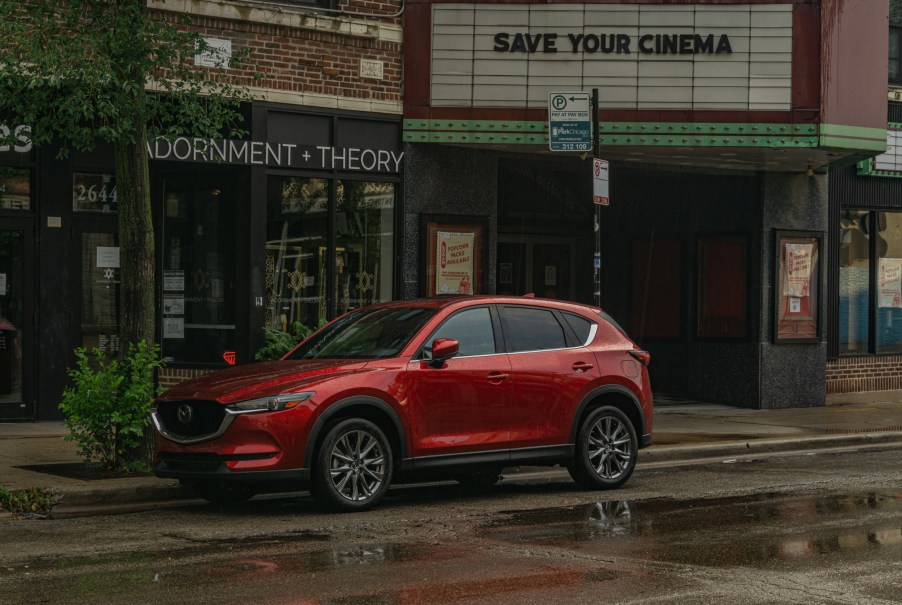
The 2020 Mazda CX-5 Needs To Work on These 3 Flaws
There’s a lot to recommend about the Mazda CX-5. It’s arguably the Japanese automaker’s best SUV/crossover, and can more than stand up to segment sales leaders like the Toyota RAV4 and Honda CR-V. And for the 2020 model year, Mazda improved every CX-5 trim level, from the Sport to the Signature. But after driving the 2020 CX-5 Signature AWD for a week, I found a few things that still need tweaking.
The interior is almost flawless

Mazda is positioning itself as a luxury or near-luxury brand, and the 2020 CX-5 Signature shows that’s not wishful thinking. There’s a reason it’s a genuine BMW X1 competitor.
The $37,155 Signature trim comes with real wood trim, Nappa leather, and LED lighting, Autotrader reports. It also has a heated steering wheel, heated rear seats, as well as heated and ventilated front seats, Autoweek reports. On the technology front, the CX-5 Signature comes with a heads-up display, navigation, heated power-folding mirrors, and a 360° camera system. Plus, the 2020 CX-5 offers a full ADAS suite, including parking sensors, adaptive cruise control, and blind-spot monitoring.

All this adds up to a genuine luxury experience. The seats are comfortable if a little firm. There’s plenty of soft-touch plastic, and neither the leather nor wood feel cheap. Also, while car design is always subjective, my passengers had nothing but compliments for the interior looks. Plus, as part of the 2020 update, the Mazda CX-5 gained more sound insulation—and it shows in the relative lack of interior noise.

However, the Mazda CX-5’s interior isn’t quite perfect. For one, there’s still some shiny black plastic trim. It’s not bad in terms of quality, but it does pick up fingerprints easily. And it can make the interior feel a little too dark for some. Plus, while the leather itself is of good quality, in some areas it feels a little thin.
Also, while the cupholders are well-positioned, it’s a slightly different story with the center armrest. It’s just a bit too far back to allow you to rest your arm there while also holding onto the wheel. And it doesn’t slide forward, likely due to those cupholders.
The 2020 Mazda CX-5 Signature AWD’s engine is a little too rough and thirsty

For 2020, the range-topping Mazda CX-5 Signature comes with a 2.5-liter turbocharged four-cylinder engine, rated at 250 hp and 310 lb-ft. However, those are the figures when it’s burning 87-octane gas. If you fuel up with 93-octane, the output increases to 250 hp and 320 lb-ft.
Regardless of fuel choice, the engine is linked to a 6-speed automatic and an all-wheel-drive system. It’s standard on the Mazda CX-5 Signature and optional on the other trims. And all this lets the CX-5 go 0-60 in 6.4 seconds, almost 2 seconds faster than the previous 2.5-liter-equipped model, Motor Trend reports.
Driving the 2020 Mazda CX-5 on city streets and on the highway, a lack of power wasn’t an issue. The throttle response is good, and the transmission shifts smoothly. However, both I and Roadshow noted quite a bit of coarseness in the exhaust note. One that cuts through the extra noise insulation. If Mazda is serious about the CX-5’s luxury aspirations, that could turn some potential buyers off.
The 2020 Mazda CX-5 Signature AWD also isn’t quite as fuel-efficient as the competition. It came last in Car and Driver’s crossover comparison, behind the RAV4, CR-V, the Subaru Forester, and the Ford Escape. The EPA rates it at 22 mpg city and 27 mpg highway. But over 127.9 miles of mixed driving, I saw 22.37 mpg. It’s significantly more efficient than the 4Runner TRD Pro I recently drove, but the CX-5’s rivals are even more so.
The 2020 Mazda CX-5 AWD’s brakes aren’t quite as responsive as its steering
Part of the Mazda CX-5’s appeal is its handling, Autoweek reports. And it is indeed praise-worthy, which is why it’s on Car and Driver’s 10Best list.
The steering is taut but not overly sharp, the suspension is a bit stiff but well dampened, and the chassis is solid. And it never feels top-heavy. Plus, the crossover features what Mazda calls ‘G-Vectoring Torque Control,’ which cuts torque briefly at the beginning of a corner to transfer weight forward. That helps give the tires additional traction for a sharper turn-in. It’s not a Miata, but you’d be forgiven for thinking the Mazda CX-5 is a tall-riding sports car. Car and Driver compares it to a Volkswagen GTI in terms of driving fun.
Unfortunately, the brakes let the CX-5 down in this regard. Not because they’re bad—they’re effective and easy to modulate. However, I noticed the same “squishy” feeling in the brake pedal’s travel that Autoweek reported. You press the pedal, and for a split second, there’s no sensation of braking—and then you start slowing down. It’s that slight delay that breaks (no pun intended) the Mazda CX-5’s sports car illusion somewhat.
To be fair, the alternative—an overly-aggressive brake pedal—would be even worse. But in the face of the Mazda CX-5’s athleticism, it could use some improvement.
Follow more updates from MotorBiscuit on our Facebook page.


